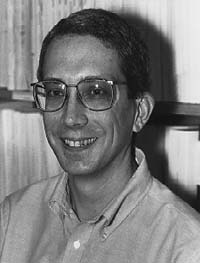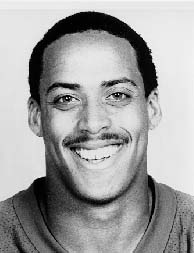Work Begins on $3 Million CSDA Population Study
By Greta Petry
 Stewart Tolnay, director of the Center for Social and Demographic Analysis,
is beginning to implement a $3 million population center “core grant”
awarded by the National Institute of Child Health and Human Development
this summer.
Stewart Tolnay, director of the Center for Social and Demographic Analysis,
is beginning to implement a $3 million population center “core grant”
awarded by the National Institute of Child Health and Human Development
this summer.
“The grant just began October 1,” said Tolnay, and we’ve already hired three people. We’ve also started a national search for a senior demographer to be associated with the center — we are looking for someone who does social demography — they can be from the fields of geography, criminal justice, psychology, anthropology or sociology, and they would have a regular faculty position in one of those departments.”
The grant will be used to support the work of about 30 Albany faculty across a variety of disciplines. Awards are extremely competitive, with funds being granted to only 11 population centers in the nation, including centers at Princeton, Brown and Johns Hopkins University.
“This grant is really going to make all the difference in the world to us,” Tolnay said. “It represents a quantum leap in the level of support that we can provide to researchers.”
Researchers affiliated with the center study general population issues including: residential mobility out of distressed neighborhoods; sex differences in the treatment of heart disease; adolescent decision-making about drinking and driving; the transmission of anti-social behavior among at-risk populations; patterns of residential segregation; and the mobility of immigrant groups to the suburbs.
CSDA acts as an umbrella that centralizes resources and support in order to reduce duplication of effort and to make the most efficient use of grants.
“It just provides the infrastructure for projects that are already going on,” Tolnay said.
This infrastructure provides services for population researchers under three research cores. Tolnay directs the administrative core, which helps researchers prepare grant proposals for submission to agencies and foundations. This includes monitoring project budgets, as well as organizing the center’s colloquium series. The second section is the computing and statistical core, which is directed by Timothy Gage of the Department of Anthropology and provides a state-of-the-art computing platform. The third part is the information and data services core, directed by Eleanor Gossen, which helps researchers locate and obtain data. Gossen is the University’s official Interuniversity Corsortium for Political and Social Research representative.
Until now, the center has been located in the basement of Dutch Quad, in an old bomb shelter that was converted into 1,200 square feet of office cubicles.
“This is where we have been located all along. It’s far too small to accommodate the expanded center,” Tolnay said, adding he has requested 5,000 square feet of space. A final decision is pending on where the center will move. Thanks to the grant, the center will be able to purchase several new computers and other equipment to support the work of the researchers.
“We are very happy about the award,” said Tolnay. “Albany was successful largely because of the important and high quality work by researchers affiliated with our center, and because of the University administration’s strong commitment to the center’s effort to become competitive for such a prestigious award. It really puts us on the map.”
Judy Genshaft, Provost and Vice President for Academic Affairs, said, “We are very proud of the work of Professor Tolnay and his collaborators. This award highlights the center’s emergence as a nationally recognized population research center in a relatively short period of time.”
Grid Star to Talk on Drink and Sex Abuse
By Greta Petry
 Don McPherson, former All American football player for Syracuse University
and NFL star, will be the featured speaker at a presentation on Drinking
Till It Hurts: Straight Talk about Alcohol and Sexual Assault, Tuesday,
Oct. 21, at 8 p.m. in the Campus Center Ballroom. His talk is being
co-sponsored by the University Counseling Center, Division of Student
Affairs, and St. Peter’s Addiction Recovery Center as part of National
Collegiate Alcohol Awareness Week.
Don McPherson, former All American football player for Syracuse University
and NFL star, will be the featured speaker at a presentation on Drinking
Till It Hurts: Straight Talk about Alcohol and Sexual Assault, Tuesday,
Oct. 21, at 8 p.m. in the Campus Center Ballroom. His talk is being
co-sponsored by the University Counseling Center, Division of Student
Affairs, and St. Peter’s Addiction Recovery Center as part of National
Collegiate Alcohol Awareness Week.
McPherson is director of Northwestern University’s Center for the Study of Sport in Society’s “Mentors in Violence Prevention Program,” which encourages men to be proactive in the effort to stop violence against women. A native of West Hempstead, he was a two sport college All-American athlete (football and track). He attended Syracuse University from 1983-1988. While there, he played quarterback and compiled 22 school records. In 1987, he led the nation in passing and Syracuse University to an undefeated record. He was a consensus All-American selection and the winner of more than 18 national player-of-the-year honors, including the McLovell Award (as the nation’s top collegiate player), the Dave O’Brien Award, and the Johnny Unitas Award (nation’s outstanding quarterback), and he was runner-up to Tim Brown of Notre Dame in the Heisman Trophy voting.
 McPherson spent two seasons with the Philadelphia Eagles of the NFL, and
joined the Houston Oilers in 1990. He also played in Canada for the
Hamilton Tiger-Cats (1991-93) and Ottawa Rough Riders (1994).
McPherson spent two seasons with the Philadelphia Eagles of the NFL, and
joined the Houston Oilers in 1990. He also played in Canada for the
Hamilton Tiger-Cats (1991-93) and Ottawa Rough Riders (1994).
He has appeared on the “Phil Donahue Show” and ABC’s “Nightline” to discuss athletes, domestic violence, and racism in professional football.
Workshops on preventing alcohol abuse among students will be offered throughout National Collegiate Alcohol Awareness Week Oct. 19-25. These include:
• Monday, Oct. 20, 1:15 p.m., Carl Walker, staff psychologist at the University Counseling Center, will run a workshop on Looking Past the Prejudice: Alcohol and Native Americans, in Campus Center 375.
• 7 p.m. that evening, in the Skin Room of Indian Quad, Middle Earth peer educators will offer students a workshop on positive and healthy ways of Beating College Stress.
• Tuesday, Oct. 21, 1:15 p.m., CC 375, Norreida Murnane, alumna and legislative analyst for educational issues, on How the Family that You Grew Up in Affects Your Current Relationships.
• 2:45 p.m., CC 375, M. Dolores Cimini, University Counseling Center coordinator for Alcohol and Drug Prevention, offers a workshop, Women and Alcohol: Are We Really that Different from Men?
• Wednesday, Oct. 22, 1:15 p.m., CC 375, Richard Lucey Jr. of the New York State Office of Alcoholism and Substance Abuse Services and Erin Loffredo of DE Associates will present a Reality Check: Alcohol and other Drug Abuse on Today’s College Campuses.
• Oct. 22, 7:30 p.m., State Quad Flag Room, the Hooray Players from Middle Earth, made up of undergraduate students act out situations related to alcohol, such as conflicts with friends and DWI.
• Thursday, Oct. 23, 1:15 p.m., CC 375, Carol Stenger, health educator with the University Counseling Center, will present AIDS and Alcohol: A Deadly Mix.
• At 7 p.m., Campus Center Assembly Hall, Mary Buscillion and the RID Victim Impact Panel present a workshop at which participants meet surviving relatives of college-age students who were killed by drunk drivers. These relatives, one of whom is the mother of a former University student, will present powerful personal stories of the ways in which fatal drunk driving accidents have changed their lives.
All events during National Collegiate Alcohol Awareness Week are accessible to individuals with disabilities. Those that require special accommodations to attend may contact Cimini at 442-5800.
Gebhardt, Albany Viewed as Leaders in Anti-Binge-Drinking Fight
Binge drinking has caught the attention of the nation because of recent college-student deaths attributed to the craze. And when colleges seek to combat this misuse of adult beverages, and when the media look for experts in the field, a person turned to more and more has been the University’s Thomas Gebhardt, director of Personal Safety and Off-Campus Affairs.An article in the Oct. 2 Christian Science Monitor, “More Colleges Struggle to Cap Beer Culture,” in noting that binge drinking “points to a deeply ingrained culture of student drinking in America — a vexing problem that is forcing more campuses to experiment with aggressive new ways of curbing alcohol abuse,” cited as a positive step the University at Albany’s agreement with off-campus tavern owners to curb happy hours and avoid selling to minors.
Then, in the aftermath of this month’s alcohol-poisoning death of a freshman at Massachusetts Institute of Technology, an article in the Oct. 5 Boston Globe sought out Gebhardt in seeking those “alliances among college officials, students, faculty, local police and municipal leaders, tavern owners and liquor retailers, fraternities and sororities, landlords, and leaders in nearby neighborhoods,” that could effectively reverse the situation.
‘’The problem can’t be solved by the university alone,’’ said Gebhardt in the piece. Noting that Albany began dealing with excessive student drinking in 1990, and that it now has the tavern-owner agreement to stop promoting cheap-drink specials “and to start carding undergraduates to ensure they are of age,” Globe medical writer Richard A. Knox concluded, “Albany’s multi-pronged approach has paid off.
“A hot line for neighbors to complain about rowdy students has seen a 76 percent drop in calls between 1991 and 1996. Complaints about noisy parties have fallen by 62 percent.”
The press has been hearing about Albany through Gebhardt’s travels to other campuses. On Sept. 29 in Columbus, Ohio, he was one of two guest speakers at the second meeting of “The Ohio 19,” a group of 19 universities and colleges in Ohio that are making a stand against binge-drinking and driving on Ohio campuses and their communities.
“I address the campus & community collaboration that the University has forged with the neighborhood associations,” said Gebhardt, in reference to an alliance — The Committee on University and Community Relations — which this year won a Neighborhood USA top prize. “Such collaborations show how we focus on addressing the critical problem of off-campus underage drinking by involving local police, taverns, fraternities, student leaders, civic leaders, and other colleges.”
In August, he gave a presentation at a videoconference on “Promising Interventions to Reduce Underage Drinking in College Communities.” in August for college and government officials from New Paltz and Oneonta, held at the University’s east campus.
And on Oct. 24 in Bedford, Mass., Gebhardt is again scheduled to speak at a media seminar at the Higher Education Center of Alcohol and other Drug Prevention, sponsored by the Robert Wood Johnson Foundation. It will be attended by faculty/staff/administrative teams from 12 colleges and universities.
Vinny Reda
